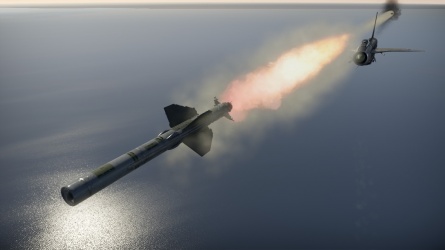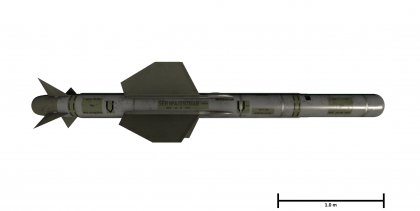Red Top

Contents
Description
The Red Top is a British Infrared homing air-to-air missile, it was introduced in Update 1.97 "Viking Fury", along with the Lightning F.6 (the first aircraft to carry it). The Red Top is one of the largest air-to-air missiles in the game, it is longer than any other air-to-air missile, while being second only to the Matra R530E in terms of weight, and having largest explosive mass (31 kg) of any air-to-air missile.
Vehicles equipped with this weapon
General info
Tell us about the tactical and technical characteristics of the missile.
Effective damage
The Red Top's warhead has the largest explosive mass of any air-to-air missile in the game, with 31 kg of TNT. This makes the Warhead very powerful and coupled with a wide proximity fuse range gives it a very large blast radius. On account of the massive warhead Red Top detonations tend to be immediately fatal to aircraft within the blast radius. However there are times (usually when the enemy aircraft is only just within the proximity fuse range and moving away from the missile) where enemy vehicles can survive, albeit usually with (often critical) damage.
Comparison with analogues
The missile most comparable to the Red Top is it's direct predecessor, the Firestreak. Both are British missiles were designed to be used in the interception of Soviet bombers, and feature large warheads with reasonable overloads and uncaged seekers which support radar slaving.The Firestreak has better initial acceleration than he Red Top, and possibly better range in some circumstances, however the red Top has a much better seeker, being able to follow targets better, and perform attacks from the side of targets much better. Compared to most other missiles the Red Top has fairly poor range, particularly when fired from directly behind targets, however this can be compensated for my shooting at targets from the side. The 16 G overload is the same as that of the AIM-9D, and is better than most early missiles, however it is inferior to later missiles such as the AIM-9J, R-60 and Matra R550.
Usage in battles
Describe situations when you would utilise this missile in-game (vehicle, pillbox, base, etc)
Pros and cons
Pros:
- Has an uncaged seeker with wide gimbal limits
- Can lock on to targets from the side aspect very well
- Can be extremely hard to dodge when fired from side aspect
- Massive warhead with large blast radius
- Supports radar slaving
Cons:
- Performs poorly when fired from directly behind an opponent (unless you have a speed advantage)
- Loses speed very quickly after the motor burns out
- Overall poor range at low altitude (can be mitigated by firing while approaching the target from the side)
History
Red Top originally started as a relatively simple upgrade to Firestreak, then still known as "Blue Jay". This Mark IV version added an improved seeker and motor, but was otherwise similar to Firestreak.
When the F.155 interceptor program was started, the design underwent a much more significant upgrade and was given the new name "Blue Vesta". In order to deal with the higher speeds, and thus temperatures, that would be encountered during extended supersonic flight, the control surfaces were made of steel and modified to a clipped-delta shape to keep the surfaces clear of the shock cones. A new all-aspect seeker was also developed, allowing head-on attacks against Soviet bombers. The resulting design was very advanced for the era, but the RAE concluded that there would be no chance for the pilot to lock on and fire as two Mach 2+ aircraft approached head-on. Blue Vesta was cancelled in favour of a radar-seeking missile.
When F.155 was cancelled in 1957, the RAF was left with no modern weapon for its new EE Lightning. They argued that the Tu-22 "Blinder" represented a credible near-term threat that the Bristol Bloodhound missile would not arrive in time to counter, while the Firestreak's demands for a tail-chase would make it too hard to use against the Blinder. The new concept used a less expensive seeker than the one for Blue Vesta, offering all-aspect performance against a supersonic target, but not a subsonic one. The new concept was given the name "Red Top".
By this time the transistor had matured as a militarily useful item, which allowed the seeker electronics to be made much smaller and lighter, and removed the need for in-flight cooling and heating required by Firestreak's valves. This opened up considerable internal room, which was used to greatly increase the size of the motor and warhead, and reposition the proximity fuses for a better view of the target. It also eliminated the need for the complex plumbing and bottles of air and ammonia formerly stored in the Firestreak's mounting pylon.
While best known on the Lightning, the missile also equipped the Sea Vixen; when launched from the subsonic Vixen, the larger motor allowed it to reach much higher speeds than the Firestreak and greatly improved its range and effectiveness. The new seeker also offered much wider engagement angles, up to 30 degrees on either side of the centerline, allowing it to be fired under a wider variety of approaches. Against its intended target, the Blinder flying at Mach 1.5, it could be used in a head-on approach at up to 22 km range. Against a subsonic target, which required a shot from the rear at up to 90 degrees to the side, it could be fired at around 5 to 7 km.
Red Top entered service in 1964, arming the Sea Vixen until its retirement in 1972, and the Lightning until its retirement in 1988. On the Lightning, Red Top's larger fins made the aircraft unstable at high speed, and a larger rudder was required. This meant the Firestreak remained in service beside Red Top on earlier aircraft.
Media
An excellent addition to the article would be a video guide, as well as screenshots from the game and photos.
See also
External links




